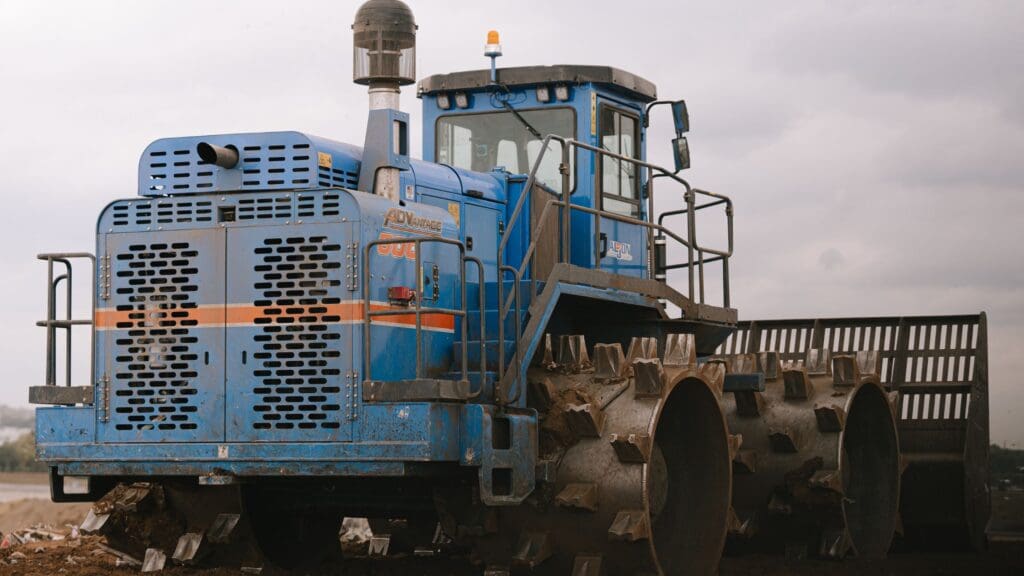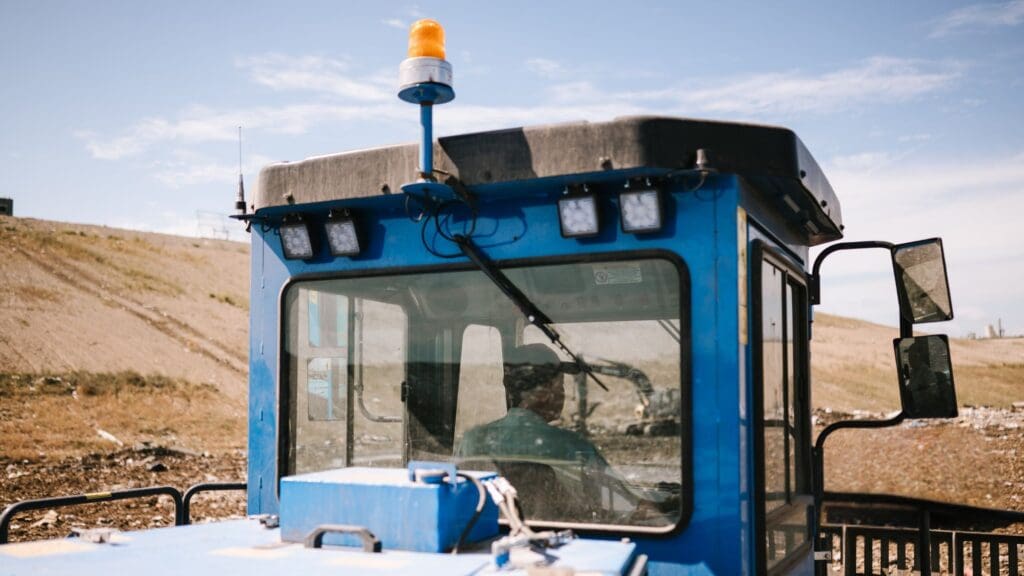Landfills provide a lot of services to their communities, but to stay in business, they have to manage one primary asset: airspace. New landfill cells are expensive to build and require extensive permitting and collaboration with many different stakeholders, but once the area is approved, it can be filled with an unlimited amount of material until its maximum height is reached.
Because airspace is the most valuable asset of any landfill operation, increasing compaction ratios is a high priority. If even slightly more material can be stored safely in the same volume, it benefits both the landfill business and the surrounding community, potentially for multiple generations. This makes landfill compactors one of the most important pieces of equipment for the operation, and the one that makes the most sense to invest in. For over 60 years, Aljon has carefully designed and improved its landfill compactors with this one goal in mind: improving landfill airspace.
Landfill compaction is a relatively straightforward process, so improving compaction performance requires a multi-pronged strategy:
- Increasing equipment uptime
- Improving PLI
- Implementing state-of-the-art wheel design
- Integrating mechanical and drive train advancements
Aljon’s singular focus on creating effective, purpose-built landfill compactors means that every one of these design aspects has been honed to provide top-of-the-line performance and reliability. Alongside these top-performing machines, Aljon has also created a legacy of exceptional customer service to keep machines running in less-than-ideal conditions and minimize wait and repair times when problems do arise.
Why Uptime Matters
There are many features and design choices (self-cleaning wheels, overall weight distribution, wheel size, cab technology, etc.) that impact the amount of waste a compactor can process in a day and how densely it can pack the material. Regardless of how efficient and effective it is while running, however, all of those gains disappear if the landfill compactor suffers from excessive (or, worse, unexpected) downtime. Proper compaction takes multiple coordinated passes over thin layers of material, and rushing this process will result in worse ratios of solid waste compaction and inefficient use of airspace, raising operational costs over time. Improving landfill compactor uptime by finding one that is low maintenance is arguably the easiest and most important way to optimize a landfill’s airspace and profitability.
Low-maintenance machines need to have two features: minimal, straightforward routine maintenance needs and uncomplicated, easy-to-repair systems. All landfill compactors come with manufacturer recommendations for service timelines and maintenance schedules to keep machines at their most efficient (and long-lived). In the real world, however, even tight operations will face days with frigid weather, excessive rain, or blistering heat that make crawling under or over a 100,000 lb machine to reapply grease or clean debris seem unbearable. Easy-access maintenance points may seem like a luxury, but they both speed up maintenance (reducing downtime immediately) and make it more likely that operators and techs will adhere to the prescribed schedule (reducing downtime in the future).
In addition to ease of access, simple designs with fewer moving parts (e.g. hydrostatic drive trains vs. powershift transmission drive trains) have fewer maintenance points to attend to (greasing, cleaning, etc.) – and they create fewer opportunities for things to break down. Fewer friction points mean less strain and wear-and-tear and fewer components to keep track of or replace. When something does break, whether due to age, mishandling, or just the wear-and-tear of the job, having to repair or replace fewer parts keeps costs down as well as reducing the time it takes to install new components. Certified technician time is expensive, and the easier the repairs are, the more quickly and inexpensively they can be completed. Low-maintenance landfill compactors continue to pay dividends the longer they stay in service, making them an excellent long-term investment.
Improve PLI
Compaction depends on two things: the weight of the compactor and the width of the wheels. More weight translates to more pressure being exerted on the compressible material below the wheels. Narrow wheels channel that pressure into a smaller area. While PSI (Pounds per Square Inch) is a common measurement in many other fields, landfill compactors are rated by PLI (Pounds per Linear Inch) for easier comparison. To calculate PLI, simply divide the weight of the compactor by the total combined width of all 4 wheels. PLI directly translates to how well the compactor will remove air from the working face of a cell.
Improving PLI requires maintaining a delicate balance. Narrower wheels will increase the amount of pressure on the material under the wheels, but if they are too narrow, they will leave a wide channel of uncompressed material between them, requiring extra passes by the compactor to even things out. They are also more likely to get stuck in uneven material. On the other hand, if the wheels are too wide, they will start to “float” over the material instead of compressing it down, similar to the tracks on a dozer.
Weight can be increased in a number of ways. Larger compactors obviously weigh more, especially when built with solid steel frames and components. As a bonus, larger compactors like Aljon’s ADV 600 also have higher-power engines and can process more material in a day (up to 1300 tons per day compared to 1200 and 950 tons for smaller models). Some manufacturers also put ballast in their wheels to increase weight, but this can create major maintenance headaches down the road if leaks form and the ballast needs to be replaced.
The key to getting the most out of a given amount of airspace is to increase the density of compacted waste. Many smaller landfills find that even if they don’t need the higher processing capacity of larger machines, the increased PLI saves them money by preserving airspace and increasing compaction ratios. Aljon compactors have the highest PLI by class in the industry, making them a top choice for improving landfill airspace.
Elite Wheel Design For Better Performance
Although overall weight and wheel width determine PLI, landfill compactor wheels do much more than just translate force onto the surface of the working face. Wheels must provide stability, steering, and motion as well as act as cutters and crushers, thanks to the cleats covering the surface. Ineffective wheels can dramatically reduce compaction ratios and leave dangerous and wasteful air pockets scattered throughout the cell by not spreading and compacting evenly. This can introduce the risk of water penetration and runoff into the neighboring soil as well as increase the fire risks present when air remains trapped inside a cell. If a fire breaks out, the cell must often be dismantled to put it out, as landfill fires are difficult to completely extinguish from the outside. Smoke and other toxic fumes can wreak havoc on both the surrounding environment and on working conditions inside the landfill – a worst-case scenario for everyone involved.
Landfill compactor cleats are vital components to the function of compactor wheels. Rather than just crushing material as flat wheels (like steamrollers) would, they actually spread the material out thanks to their angled design. They also cut and shred material as they puncture through new layers of waste. Smaller pieces of material are much easier to spread evenly, preventing awkward dips or protrusions that can compound as more material is added. Without this shredding action, larger objects would only be crushed to a certain point, and any air inside would remain a vacant pocket rather than being returned to the landfill airspace. Air pockets are both dangerous and costly to the operation.
Cleat design consists of the shape of the cleat itself (most are shaped like wedges, with varying shapes on the end, such as truncated edges or angled “W” teeth). They can also be manufactured out of different materials and have abrasion-resistant coatings – something that matters a lot with materials that are constantly experiencing friction as well as the impact of weather, corrosive fluids, etc. Aljon uses MacPactor cleats with a long wear-life guarantee to improve durability and extend the lifespan of compactor wheels.
While the cleats help puncture and shred material, they are not the primary compacting agent: the flat surface of the wheel itself is what delivers the crushing force needed for even, high-density compaction. This means the whole wheel must contact the surface. If too many cleats are used, the wheel may ride on the surface of the cleats instead of making contact with the material under it, causing uneven compaction and poor shredding of the layer. Too few cleats, on the other hand, won’t provide enough shredding and won’t spread cut material across the surface well enough for maximum compaction on a large scale. At Aljon, cleat configuration has been carefully designed to maximize compaction and increase the life of all compactor wheels and cleats.
Finally, poorly designed wheels and cleats are a major source of maintenance woes. If material gets jammed in between cleats because they are too close together or wire gets wrapped around the axle, work must be stopped so that the wheels will function as intended (or compaction ratios may be reduced until the maintenance takes place). Even if the cleat designs work exceptionally well, if they require constant cleaning, overall efficiency will suffer. Some compactors come with add-ons like wire cutters and guards that help prevent buildup, but these extra parts must be maintained and replaced, increasing downtime as well as costs. Aljon’s self-cleaning wheels maximize contact with the working face and limit maintenance downtime, resulting in better compaction ratios.
Mechanical and Drive Train Enhancements
There are a few mechanical features, such as an I-Beam chassis that prevents buildup, that can take compactors from effective to elite. One key feature is the addition of a frame design with rear-axle oscillation. On rugged terrain or large slopes, one or more wheels can lift off the ground, causing uneven compaction (and decreasing the stability of the compactor). A landfill compactor oscillating frame design allows the rear axle to shift with the terrain, keeping all four wheels in contact with the surface. This makes the compactor safer and more effective on even the most difficult slopes and has been proven to assist in its overall goal of removing air from a landfill’s working face.
Additionally, upgrading from a powershift transmission drive train to a hydrostatic drive train can dramatically improve the compactor’s efficiency. Widely renowned for its ease of use, hydrostatic drives operate smoothly and effectively. This lowers the learning curve and increases safety for new operators. It also allows for quick reversing and excellent maneuverability in difficult spaces. All four wheels are powered individually via a hydraulic fluid system and individual motor, so it is always in four-wheel drive, improving gradeability. Coupled with the oscillating frame system, Aljon compactors have 100% gradeability.
Together, all of these factors make Aljon landfill compactors a desirable choice for improved compaction ratios and better use of landfill airspace. With stringent standards for maintenance and uptime, the highest PLIs in their class, state-of-the-art wheel design, and thoughtful mechanical and drive train improvements, these landfill compactors were designed for a single purpose: to return air in the working face to the landfill airspace, extending the life of every landfill cell.



